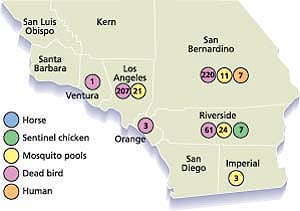All Issues
West Nile virus spreads
Publication Information
California Agriculture 58(3):133-134.
Published July 01, 2004
PDF | Citation | Permissions
Full text
As of June 22, California health officials had confirmed seven human cases of West Nile virus (WNV) in 2004, including a 61-year-old San Bernardino County man hospitalized with encephalitis. The virus, which is transmitted from birds to mosquitoes to humans (or horses), has also been confirmed in nearly 500 dead birds in Los Angeles, Riverside, San Bernardino and Ventura counties.
“What the dead birds are telling us is that there's a lot of virus circulating out there,” says John Edman, director of the UC Davis Center for Vectorborne Diseases (UCD/CVB). “We're in a high state of alert.”
UC Davis scientists are collaborating with the California Department of Health Services, California Department of Food and Agriculture, local mosquito and vector control districts, and other agencies on a statewide surveillance program for WNV. The UCD/CVB biocontainment laboratory tests tissues from all reported dead birds, blood from sentinel chickens (in 232 flocks of 10 each), and pools of 50 mosquitoes each gathered from nearly 3,000 traps around the state ( see figure, page 133 ).
As of June 22, 2004, California's surveillance network had detected West Nile virus in humans; dead birds; aggregate pools of mosquitoes; and sentinel chickens, which have their blood drawn and tested biweekly. No infected horses have been found. Source: www.westnile.ca.gov
The risk of serious illness from WNV in humans is low, with the elderly, the young and those with compromised immune systems at greatest risk. While most infected individuals will not experience any illness or only mild symptoms, some of those infected will develop serious neurological symptoms such as encephalitis or meningitis. In 2003, 9,862 WNV cases were reported to the U.S. Centers for Disease Control nationwide, with 264 deaths.
Statewide, the UC Division of Agriculture and Natural Resources funds the Mosquito Research Program, which provides grant support for UC research projects that investigate the vectors of WNV and other mosquito-borne diseases and seek environmentally safe methods to improve mosquito management. Likewise, about 40 members of the UC Mosquito Research and Extension Workgroup are working together to establish research priorities and seek extramural funding to pursue additional WNV-related research.





